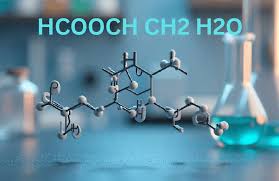Understanding HCOOCH₂ + H₂O: Chemistry Made Simple
If you’ve ever stumbled upon HCOOCH₂ + H₂O in your chemistry notes, you might have wondered what it really means. Don’t worry—this guide will break it down in a simple and easy-to-understand way.
What is HCOOCH₂?
The formula HCOOCH₂ represents a chemical compound belonging to the family of esters. Esters are organic compounds commonly formed when an acid reacts with an alcohol. They are often responsible for the pleasant smells in fruits, flowers, and even artificial flavorings. In HCOOCH₂, the structure contains a formyl group (HCO-) attached to a methylene group (-CH₂-), which makes it reactive with water.
What Happens When HCOOCH₂ Meets H₂O?
When HCOOCH₂ comes in contact with water (H₂O), a chemical reaction known as hydrolysis can occur. Hydrolysis is a process where water breaks the bonds in a molecule, forming simpler compounds. For HCOOCH₂, this reaction typically produces:
- Formic acid (HCOOH)
- Methanol (CH₃OH)
This can be written in a simplified reaction equation:
HCOOCH₂ + H₂O → HCOOH + CH₃OH
Essentially, the ester splits into an acid and an alcohol. This reaction is very important in both laboratory chemistry and industrial processes.
Why Is This Reaction Important?
Understanding the reaction of HCOOCH₂ with water is crucial for several reasons:
- Industrial Applications
Esters like HCOOCH₂ are used in making perfumes, flavorings, and solvents. Knowing how they react with water helps chemists control the production of acids and alcohols efficiently. - Laboratory Studies
Hydrolysis reactions are a staple experiment in chemistry labs. They demonstrate how molecules interact with water, helping students and researchers understand fundamental chemical principles. - Environmental Impact
Some esters can enter the environment through industrial waste. Knowing their hydrolysis pathways helps predict how they break down, contributing to environmental safety.
Factors That Affect Hydrolysis
Not every ester reacts with water in the same way. Several factors can influence the hydrolysis of HCOOCH₂, including:
- Temperature: Higher temperatures increase the reaction rate.
- Acid/Base Presence: Acids or bases can act as catalysts, speeding up the reaction.
- Water Concentration: More water usually leads to faster hydrolysis.
By controlling these factors, chemists can ensure the reaction occurs efficiently and safely.
Fun Fact About Esters
Many esters are actually the reason why fruits smell so good! For example, the smell of apples, bananas, and pineapples comes from naturally occurring esters. So next time you enjoy the scent of a fruit, you’re indirectly experiencing the chemistry of HCOOCH₂-like compounds.
Key Takeaways
- HCOOCH₂ is an ester that reacts with water in a hydrolysis reaction.
- The products of this reaction are formic acid and methanol.
- This reaction has important applications in industry, labs, and environmental studies.
- Temperature, catalysts, and water concentration can affect the reaction rate.
Understanding HCOOCH₂ + H₂O doesn’t have to be complicated. With this simple breakdown, you now know how this ester behaves in water and why it’s relevant in chemistry.







